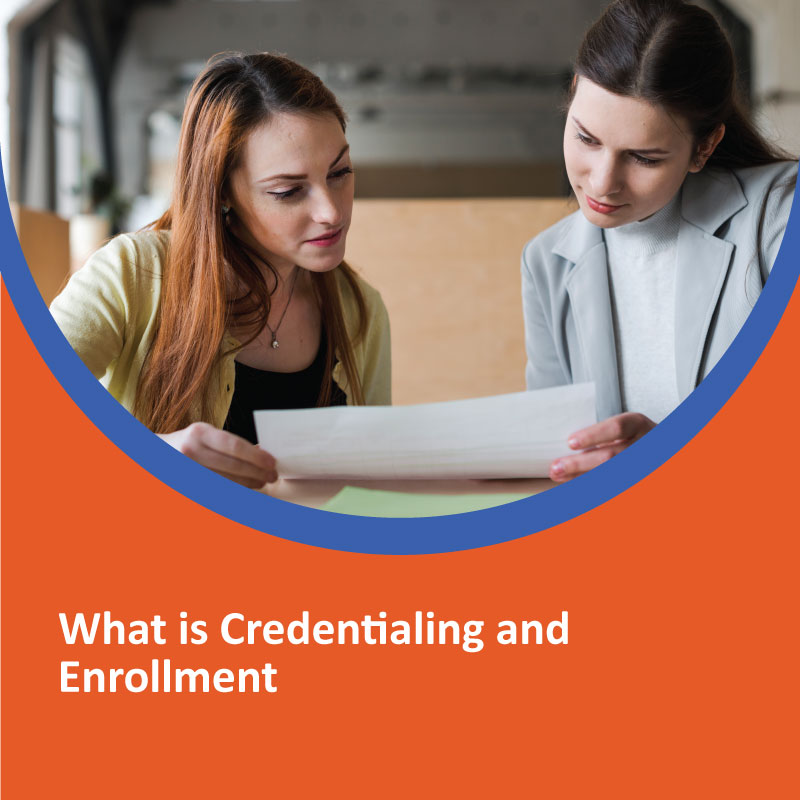Hiring unprofessional healthcare providers or letting them stick around can lead to more legal trouble for provider practices. To avoid this, you must check your providers’ credentials. Also, it is important to ensure everything is upgraded. If you do not check, it can hurt how much money your facility makes. Thus, it can put you at risk for malpractice suits.
Additionally, insurance payers might take hold of paying doctors who are not sufficiently credentialed and enrolled with them. As a result, it can hurt your practice financially. Our custom payer credentialing and enrollment services help out doctors in various situations, including:
- Joining or starting a new practice
- Switching from one group to another
- Joining new groups or practices
- Signing up with new payers
- Keeping their credentials in check
These attributes are a must to protect your facility from financial issues and ensure you follow all the rules.
What is provider enrollment and credentialing?
You should ensure your medical practice processes are handled correctly. So, it’s vital to understand the difference between enrolment and credentialing.
What is Credentialing?
Credentialing checks and confirms healthcare providers’ skills, training, and education. This involves verifying these credentials directly with the source that issued the license. Also, it consists of providing the training or delivering the education.Healthcare facilities use credentialing during their hiring process. On the other hand, payer credentialing is performed to include providers in insurance networks. Credentialing also involves validating a provider in a private health plan. Also, it is approved to join the network.
What are the important steps of Provider Credentialing?
Provider credentialing is a procedure that ensures the capability of healthcare specialists. Also, it validates the authenticity of their documentation. Let’s explore the basic steps involved in most cases:
- The payer network requests documentation from the provider, but the specific requirements can vary.
- Common details required include the following:
- Provider’s name
- Address
- Contact information
- Educational certificates
- Medical residency certificates
- Training certificates
- Specialized roles may require board certification and, sometimes, evidence of research conducted during the provider’s training period.
- The information is then sent to the credentialing committee for verification from primary sources.
- If discrepancies arise, the provider may need to provide additional documents to resolve the issue.
Provider Enrollment Simplified
Enrollment requests to be part of a health insurance network as a provider. This includes:
- Expressing interest
- Completing the credentialing process
- Submitting necessary documents
- Signing a contract
It’s also the confirmation of a provider in a public health plan. It allows them to bill the agency for services provided.
Steps to Provider Enrollment
The provider enrollment steps can be confusing as they vary among different payer networks. Here’s a simplified breakdown:
1. Credentialing
The initial step involves credentialing the provider once the required documents are collected.
2. Further Information
After completing the credentialing process, the provider might face additional queries. These queries can be about their education or past work history. It depends on the payer network’s requirements.
3. Guidance by Specialists
To ease through these crucial steps, a provider enrollment specialist assists and guides the provider.
Evolution of Provider Credentialing
Provider credentialing is basic to healthcare services. It is becoming modern with time. This important process involves verifying a provider’s education, training, experience, and expertise. It also verifies the commitment to delivering medical services.
In the 1990s, dedicated national organizations for medical provider credentialing came out. At the same time, the National Committee for Quality Assurance: NCQA established guidelines for the credentialing process and methods. Understanding this growth highlights the ongoing importance of provider credentialing. It is ensuring the delivery of quality healthcare services.
Connection between Provider Credentialing and Enrollment Services
There is a strong connection between insurance provider enrolment and provider insurance credentialing. The provider enrollment process is dependent on successful medical credentialing. The provider cannot successfully enroll in a network under a specific payer without completing the credentialing step. Furthermore, credentialing is essential to prevent claim denials.
Example:
Consider an example where a dentist applies to join Medicaid as a provider. But he skips the credentialing process. Those claims will be canceled if the dentist submits medical billing claims without proper credentialing. This is because the provider has not completed the necessary credentialing, making the contract between the provider and the network invalid. Achieving successful provider enrollment is inseparable from completing the essential medical credentialing process.
Duration of Provider Credentialing and Enrollment
The time it takes to complete the provider enrollment and credentialing procedure depends on the payer involved. Commonly, the process can take from three to six months. However, it can extend the timeline if you do not provide the necessary documentation for domestic education verification.
Importance of Provider Enrollment in Healthcare
There were more than three hundred million people in the US who had health insurance in past years. Considering the population is around 334 million, nearly every patient seeking care from a provider likely uses insurance. Provider enrollment is the first step to collaborating with a payer and receiving payment for services providers to insured patients.
The Significance of Credentialing
While provider enrollment is essential, credentialing holds additional importance. But, if a provider isn’t properly credentialed, it could imply that the quality of care supported by a payer for a patient may fall short of expected standards.
For instance, if an inadequately educated or licensed provider enrolls in a network, the network shares some responsibility if complications arise during patient treatment. Credentialing work as a checks-and-balances process. It ensures the quality of patient care is maintained.
Tips to Boost Provider Credentialing and Enrollment
Many healthcare practices considered it a challenging process to deal with provider credentialing and enrollment. But, there are many easy ways for these processes. These include the following:
1. Embrace Automation Software
Using automation software can improve the efficiency of provider credentialing and enrollment processes. Although each insurance payer has specific requirements for enrolling a new provider, many forms share essential information. Automated software can smooth the completion of these forms, saving considerable time.
2. Allow Ample Time
Give yourself a lot of time to complete these crucial processes. Delays in the credentialing or enrollment process can prevent a new provider from accepting patient payments. The more time you allocate, the less stressful the entire process.
3. Double-Check Every Detail
Take the time to review all information on each form thoroughly before submission. Even minor errors like a misspelled name or address can lead to application rejections. It can force you to start the process over. To avoid this common issue, carefully check every document to ensure accuracy and completeness.
Conclusion
In conclusion, we have discussed above that credentialing and enrollment are essential for healthcare practices. It ensures competent providers and financial stability. It is important to verify skills through credentialing in delivering quality care. Also, navigating the enrollment is crucial for receiving payments on time. Providers need to embrace automation, allocate ample time, and review details.
Moreover, understanding the process is more important to navigate the healthcare world successfully. Healthcare practices can be easier by understanding these processes’ evolution, significance, and connection. Proactive engagement in credentialing and enrollment services is necessary. Also, it is a strategic move for a thriving healthcare practice.



